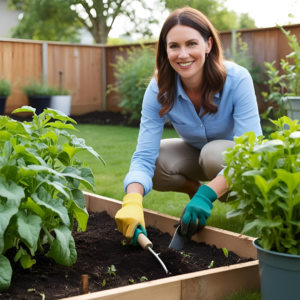Did you know that 50% of urban dwellers are turning their small outdoor spaces into lush green retreats? Even with limited square footage, it’s possible to create a vibrant balcony garden that feels like an extension of your home. I’ve always been passionate about bringing greenery into my life, and I’m excited to share balcony gardening ideas.
Planning is key when working with a compact area. By using vertical space and creative containers, you can maximize every inch. I’ve found that combining style with practicality makes a huge difference. For example, tiered planters can triple your growing space, while lightweight materials make rearranging a breeze.
Adding plants to your outdoor area not only beautifies the space but also enhances your mood. Studies show that colorful arrangements can boost well-being by up to 30%. Whether you’re growing herbs or decorative flowers, the possibilities are endless. Let’s explore how you can transform your small space into a green oasis.
Key Takeaways
- Urban dwellers are increasingly interested in creating green spaces on their balconies.
- Vertical gardening and creative containers maximize limited space.
- Lightweight materials make rearranging plants easier and more practical.
- Incorporating greenery can enhance mood and well-being.
- Planning and creativity are essential for a successful balcony garden.
Planning My Balcony Garden: Assessing Space and Microclimates
Creating a green retreat in a small area begins with understanding the unique conditions of your space. When I started planning, I knew I had to assess every detail to make the most of my limited area. This meant measuring the available space, observing sunlight patterns, and noting wind and shade distribution. It’s amazing how much you can learn with unique gardening ideas.
Evaluating Outdoor Conditions and Restrictions
First, I measured my outdoor area to understand its potential. I also checked for any restrictions, like weight limits or building rules. These factors can influence the types of containers and plants you choose. For example, lightweight materials are a must if your space has weight limitations.
Next, I observed the wind patterns. Strong gusts can dry out plants quickly, so I knew I’d need to position them carefully. I also tracked how much direct sunlight my space receives during the day. This helped me decide which plants would thrive and where to place them.
Mapping Sunlight, Wind, and Shade Patterns
Understanding microclimates is crucial for plant health. I used a simple sun calculator to track how many hours of sunlight my space gets. I found that some areas receive full sun, while others are shaded for most of the day. This knowledge helped me choose the right plants for each spot.
I also noted the time of day when the sun hits different areas. Morning sun is gentler, while afternoon sun can be intense. By mapping these patterns, I ensured my plants get the light they need without being scorched. This careful planning has made all the difference in creating a thriving outdoor space.
Choosing the Right Containers and Self-Watering Pots
Selecting the perfect containers can transform your small outdoor space into a thriving green haven. I’ve learned that the right pot not only supports plant growth but also enhances the overall look of your setup. When I started, I focused on finding containers that were both functional and stylish, ensuring they could withstand outdoor conditions while saving water and effort.
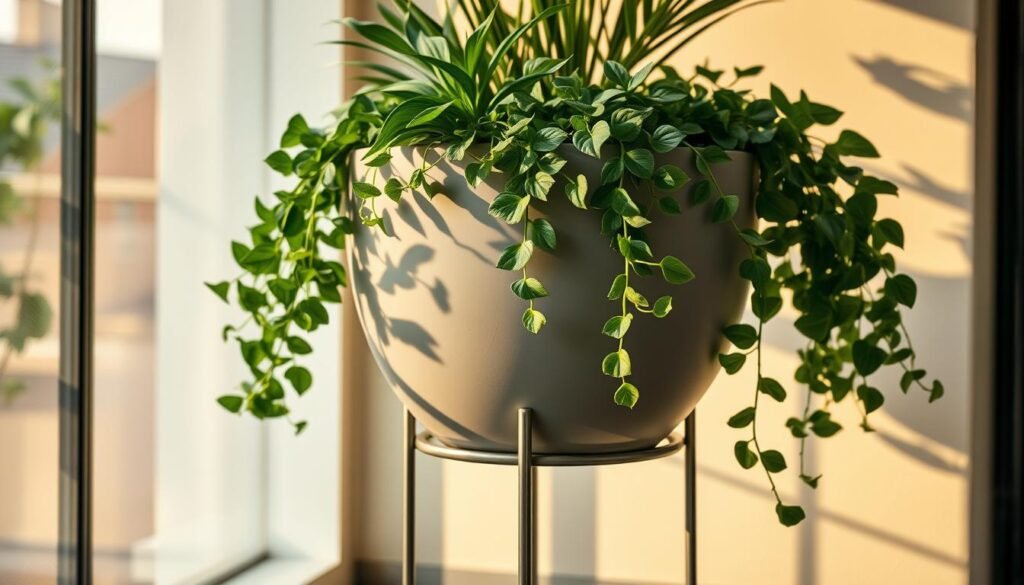
Lightweight Materials and Durable Design
When choosing containers, I prioritize lightweight materials like plastic, fiberglass, or fabric grow bags. These options are easy to move and rearrange, which is essential for windy conditions. I also look for durability to ensure they last through changing weather.
Proper drainage is another key factor. Containers with drainage holes prevent water from accumulating, which can harm plant roots. I’ve found that combining lightweight materials with good drainage creates the ideal environment for healthy plants.
Benefits of Self-Watering Options
Self-watering pots, like AquaPots®, have been a game-changer for me. They reduce the frequency of watering, making them perfect for busy lifestyles. These pots have built-in reservoirs that provide consistent moisture, ensuring my plants stay hydrated even during hot days.
Adding compost designed for container growing has also improved my results. It enriches the soil, providing essential nutrients for plant growth. This combination of self-watering systems and quality compost has made my outdoor space both low-maintenance and lush.
Maximizing Efficiency with Container Choices
Efficiency is key when working with limited space. I use a mix of sizes and styles to maximize every inch. For example, larger pots are great for vegetables like tomatoes, while smaller ones work well for herbs and succulents.
Here’s a quick comparison of container materials to help you get started with gardening:
| Material | Weight | Durability | Best For |
|---|---|---|---|
| Plastic | Light | High | Small spaces, windy areas |
| Fiberglass | Medium | High | Stylish designs, long-term use |
| Fabric | Light | Moderate | Herbs, portable setups |
By carefully selecting containers that match my needs, I’ve created a space that’s both efficient and beautiful. Whether you’re a beginner or an experienced gardener, the right pots can make all the difference.
Selecting Plants That Thrive in Small Spaces
Transforming a small space into a lush retreat starts with the right plant choices. I’ve found that selecting varieties suited to confined environments ensures they flourish and add beauty to the area. Whether you’re growing herbs, vegetables, or ornamental plants, the key is to focus on compact growth habits and efficient root systems.
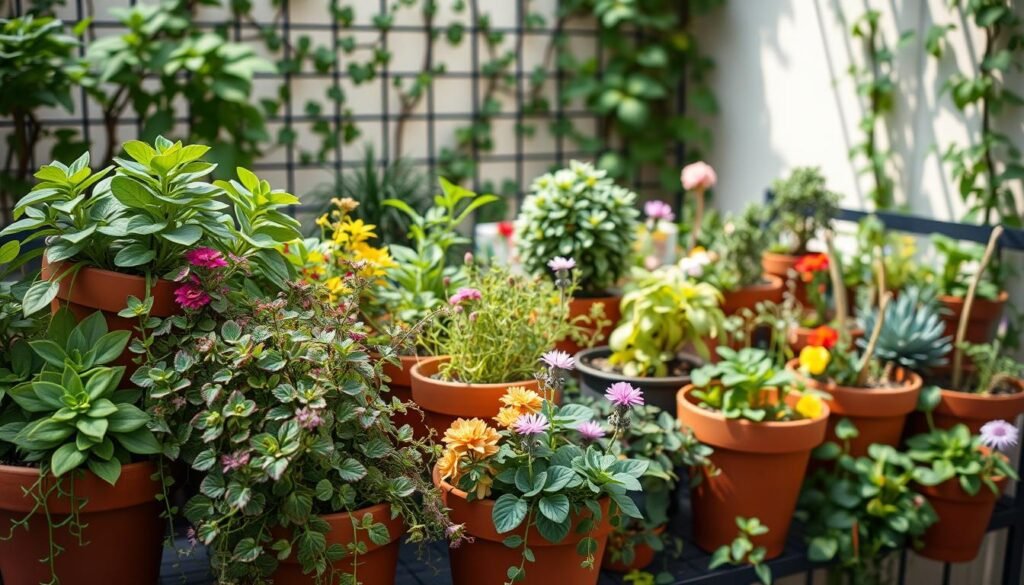
Herbs, Vegetables, and Succulents
Herbs like parsley and cilantro are perfect for small spaces. They adapt well to partial shade and don’t require much room to grow. Vegetables such as cherry tomatoes and peppers thrive in containers, especially when paired with self-watering pots. Succulents, with their low maintenance needs, add a touch of elegance and are ideal for sunny spots.
Here’s a quick list of my favorite picks for small spaces:
- Herbs: Basil, thyme, and mint.
- Vegetables: Lettuce, radishes, and dwarf beans.
- Succulents: Echeveria, jade plants, and sedum.
Climbing, Flowering, and Dwarf Varieties
Climbing plants like ivy or clematis add vertical interest without taking up much floor space. Flowering varieties such as petunias and marigolds bring vibrant colors and attract pollinators. Dwarf fruit trees, like miniature apple or citrus, are compact yet productive, making them excellent choices for limited areas.
I love experimenting with plant placement to create layered textures and colors. For example, pairing trailing plants with upright varieties adds depth and visual appeal. A well-curated selection of plants can transform even the smallest space into a lush, inviting retreat.
By choosing the right mix of herbs, vegetables, and container-based garden flowers, you can create a functional yet eye-catching outdoor area. It’s all about balance and creativity—every plant has a role to play in bringing your space to life.
Essential Balcony Gardening Ideas for Urban Living
Living in the city doesn’t mean you can’t enjoy a lush, green escape right outside your door. When I started transforming my small outdoor area, I discovered that vertical gardening and hanging planters are game-changers. They not only maximize space but also add a touch of creativity to urban living.
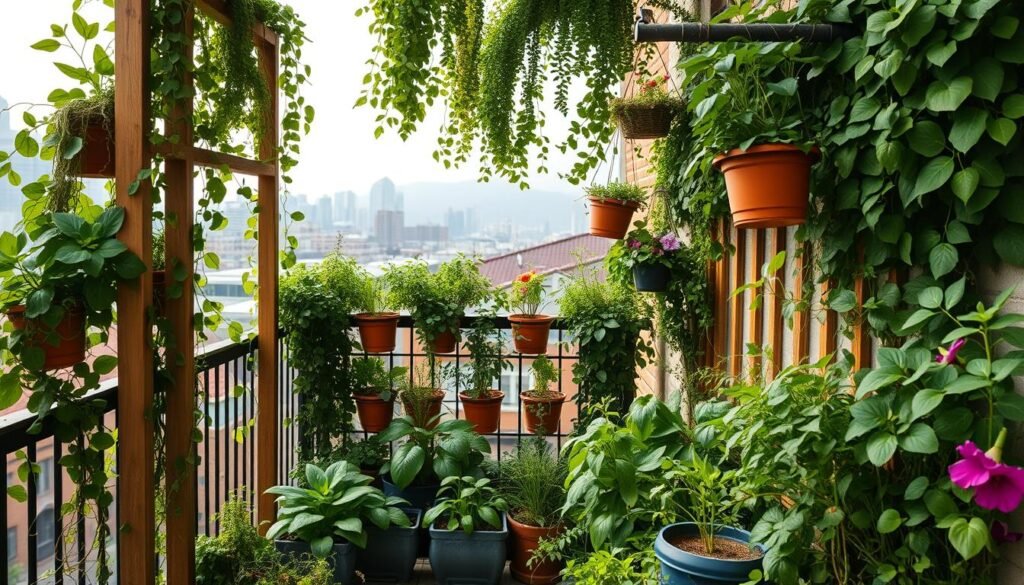
Creative Vertical Gardening and Hanging Planters
One of my favorite techniques is using walls to create a dynamic garden display. I attached lightweight planters to the wall, turning an underused space into a living focal point. For support, I used chicken wire, which is both sturdy and easy to install.
Hanging planters are another fantastic option. I hung them from railings to add lush greenery without sacrificing floor space. This approach not only looks beautiful but also ensures every inch of my outdoor area is utilized effectively.
Here are a few tips I’ve learned along the way:
- Use secure mounting systems to ensure hanging containers stay in place, even in windy conditions.
- Arrange planters at different heights to create visual flow and depth.
- Choose lightweight materials for easy rearrangement and maintenance.
By combining functionality with artistic beauty, I’ve turned my small space into a green retreat. It’s amazing how a little creativity can transform an ordinary wall into a vibrant garden.
Urban gardening isn’t just about aesthetics—it fosters a sense of community and creativity. Sharing tips with neighbors and experimenting with new ideas has made the process even more rewarding. Whether you’re a beginner or an experienced gardener, these techniques can help you make the most of your outdoor area.
Watering Techniques and Maintenance Strategies
Keeping my plants healthy while juggling a busy schedule has taught me the importance of smart watering techniques. Over time, I’ve discovered methods that save time and ensure my plants thrive, even when I’m short on it. Here’s how I manage my watering routine and maintain healthy soil effortlessly.
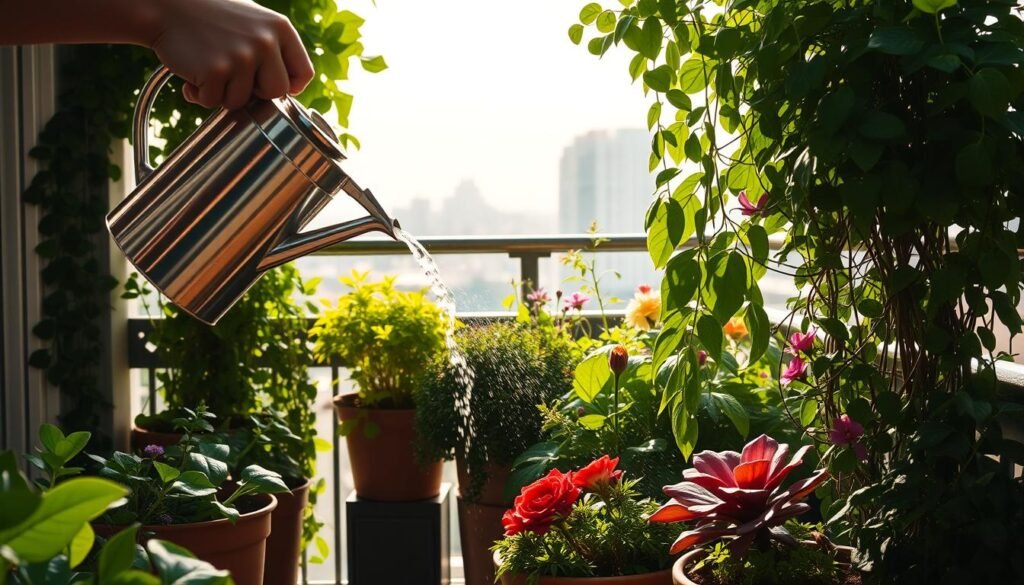
Efficient Methods for Busy Gardeners
One of my favorite tools is a collapsible watering can. It’s lightweight, easy to store, and perfect for quick watering sessions. For larger setups, I use drip irrigation systems. They deliver the right amount of water directly to the roots, reducing waste and effort.
Self-watering pots have also been a lifesaver. They keep the soil consistently moist, which is ideal for busy days. Here’s a quick comparison of my go-to watering methods:
| Method | Best For | Maintenance Level |
|---|---|---|
| Collapsible Watering Can | Small spaces, quick tasks | Low |
| Drip Irrigation | Larger setups, consistent watering | Medium |
| Self-Watering Pots | Busy schedules, moisture control | Low |
Soil Care and Seasonal Adjustments
Healthy soil is the foundation of a thriving garden. I use a moisture-retaining mix to keep plants hydrated longer. Testing soil moisture is simple—just insert your finger up to the second knuckle. If it feels dry, it’s time to water.
Seasonal changes require adjustments. In summer, I water early in the morning to reduce evaporation. During cooler months, I check the soil every few days to avoid overwatering. These small tweaks make a big difference in plant health.
Here’s a quick tip: Deep watering encourages roots to grow deeper, making plants more resilient to heat and wind. It’s a simple yet effective strategy for long-term success.
Enhancing Aesthetic Appeal and Functional Design
Bringing life to a small outdoor area is all about blending beauty with practicality. I’ve found that adding pops of color and mixing textures can instantly elevate the look of any space. Whether it’s vibrant flowers or lush greenery, these elements create a visually engaging environment that feels inviting.
Incorporating Color and Textural Elements
One of my favorite ways to add interest is by combining different plant varieties. For example, pairing trailing vines with upright shrubs creates depth and movement. I also love using decorative gardening buckets in bold colors to make the space pop. It’s amazing how a simple change can transform the entire look.
Textures play a big role too. Mixing smooth leaves with rough bark or soft petals adds layers of visual appeal. I often use repurposed building materials, like wooden pallets, as backdrops for my plants. This not only adds character but also supports sustainable practices.
Maximizing Space with Railings and Wall Gardens
When working with limited space, I focus on vertical solutions. Hanging planters on railings or installing living walls are great ways to maximize every inch. I’ve found that climbing plants, like ivy or jasmine, add a touch of elegance while saving floor space.
Here’s a quick comparison of decorative elements and their benefits:
| Element | Benefit | Best For |
|---|---|---|
| Colorful Pots | Adds vibrancy | Small spaces |
| Living Walls | Maximizes vertical space | Urban areas |
| Climbing Plants | Creates visual height | Railings and walls |
By combining decorative elements with practical considerations, I’ve turned my outdoor area into a cozy retreat. Experimenting with color schemes and plant groupings has made the space uniquely mine. It’s a perfect blend of style and functionality.
Seasonal Tips for Year-Round Balcony Garden Success
Adapting to the changing seasons is essential for maintaining a thriving outdoor space. Over the years, I’ve learned that each season brings unique challenges and opportunities. By understanding these shifts, I’ve kept my plants healthy and vibrant all year long.
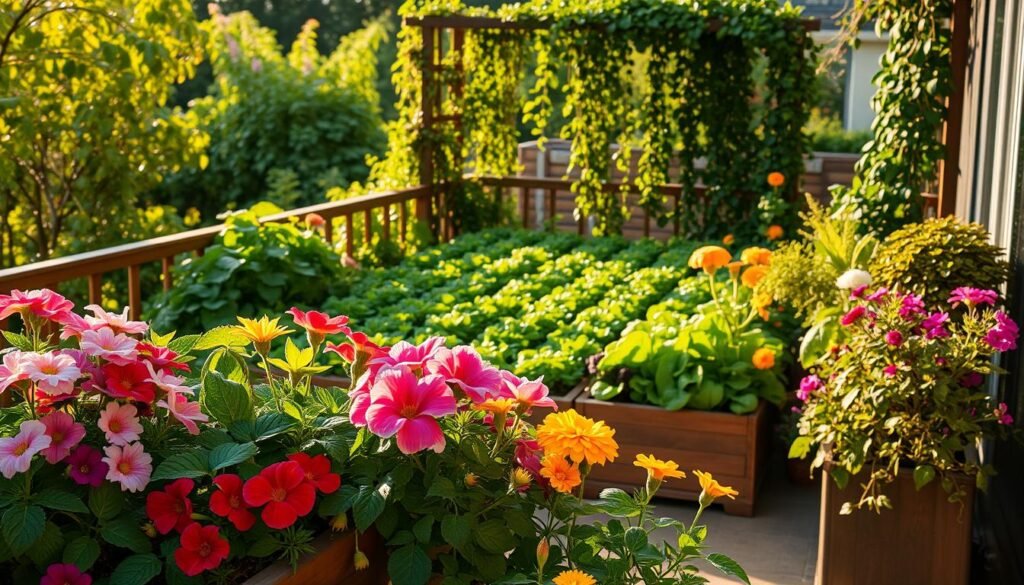
Adjusting for Extreme Weather and Microclimates
Winter and summer require different care strategies. During cold months, I protect my plants with frost cloths and move sensitive varieties indoors. In the summer, I shield them from intense sun by providing shade during peak hours.
Understanding my outdoor area’s microclimate has been a game-changer. I track how many hours of sun each spot receives daily. This helps me choose plants that thrive in specific conditions and adjust their placement as needed.
Here are some strategies I rely on:
- Use windbreaks to protect plants from harsh gusts.
- Water deeply in the morning to reduce evaporation during hot summer days.
- Select hardy varieties that can withstand temperature fluctuations.
By planning for each season, I’ve created a space that remains lush and inviting all year round. It’s a rewarding process that keeps me connected to nature, no matter the weather.
Grow Your Balcony Garden Today
Turning a small outdoor area into a green haven has been one of my most rewarding projects. From careful planning to choosing the right container and plant combinations, every step has brought me closer to creating a space I love. Even with limited space, I’ve found that creativity and thoughtful design can make all the difference.
Using a mix of herbs, vegetables, and ornamental plants has not only enhanced the look of my garden but also made it more functional. Cost-effective tips, like using self-watering systems and quality compost, have saved me money and time. These small adjustments ensure my plants thrive with minimal effort.
I encourage you to experiment with different ways to transform your own place into a green retreat. Whether it’s a pot of herbs or a vertical garden, every detail counts. Make sure to enjoy the process—it’s not just about the result but the joy it brings to your home and life.
FAQ
How do I assess the space and conditions for my balcony garden?
Start by evaluating the outdoor conditions like sunlight, wind, and shade patterns. Measure the area and check for any building restrictions to ensure your plants have the best environment to thrive.
What are the benefits of using self-watering pots?
Self-watering pots save time and reduce maintenance by providing consistent moisture to your plants. They’re perfect for busy gardeners and help prevent over or under-watering.
Which plants work best for small spaces?
Herbs, vegetables, succulents, and dwarf varieties are ideal. Climbing plants like ivy or flowering options like petunias add greenery without taking up much room.
How can I maximize space in my balcony garden?
Use vertical gardening techniques like hanging planters or wall gardens. Railings and tiered shelves also help create more room for your plants.
What are some efficient watering techniques for busy gardeners?
Self-watering systems or drip irrigation can save time. Mulching helps retain soil moisture, and checking plants early in the day ensures they stay hydrated.
How do I enhance the aesthetic appeal of my balcony garden?
Incorporate colorful flowers, textured foliage, and decorative containers. Mixing different plant heights and types adds visual interest and depth.
What seasonal adjustments should I make for my balcony garden?
In summer, provide shade and water more frequently. During winter, protect plants from frost and consider moving sensitive varieties indoors. Adjust care based on your microclimate.

